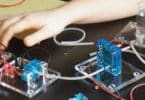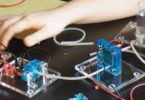Physics Capacitor Problems with Answers:
Ques: The potential to which a conductor is raised, depends on
(a) The amount of charge
(b) Geometry and size of the conductor
(c) Both (a) and (b)
(d) Only on (a)
Ques: The electric field between the plates of a parallel plate capacitor when connected to a certain battery is E0. If the space between the plates of the capacitor is filled by introducing a material of dielectric constant K without disturbing the battery connections, the field between the plates shall be
(a) KE0
(b) E0
(c) E0/K
(d) None of the above
Related: Chemistry Amines Questions
Ques: The capacity of a condenser in which a dielectric of dielectric constant 5 has been used, is C. If the dielectric is replaced by another with dielectric constant 20, the capacity will become
(a) C/4
(b) 4C
(c) C/2
(d) 2C
Ques: Eight drops of mercury of equal radii possessing equal charges combine to form a big drop. Then the capacitance of bigger drop compared to each individual small drop is
(a) 8 times
(b) 4 times
(c) 2 times
(d) 32 times
Ques: If the distance between the plates of parallel plate capacitor is halved and the dielectric constant of dielectric is doubled, then its capacity will
(a) Increase by 16 times
(b) Increase by 4 times
(c) Increase by 2 times
(d) Remain the same
Ques: Work done by an external agent in separating the parallel plate capacitor is
(a) CV
(b) ½ C2V
(c) ½ CV2
(d) None of these
Related: human health and disease online test
Ques: The capacity of a condenser is 4 x 10–6 farad and its potential is 100 volts. The energy released on discharging it fully will be
(a) 0.02 Joule
(b) 0.04 Joule
(c) 0.025 Joule
(d) 0.05 Joule
Ques: The intensity of electric field at a point between the plates of a charged capacitor
(a) Is directly proportional to the distance between the plates
(b) Is inversely proportional to the distance between the plates
(c) Is inversely proportional to the square of the distance between the plates
(d) Does not depend upon the distance between the plates
Ques: When a lamp is connected in series with capacitor, then
(a) Lamp will not glow
(b) Lamp will burst out
(c) Lamp will glow normally
(d) None of these
Ques: In a parallel plate capacitor of capacitance C, a metal sheet is inserted between the plates, parallel to them. If the thickness of the sheet is half of the separation between the plates. The capacitance will be
(a) C/2
(b) 3C/4
(c) 4C
(d) 2C
Ques: A capacitor is kept connected to the battery and a dielectric slab is inserted between the plates. During this process
(a) No work is done
(b) Work is done at the cost of the energy already stored in the capacitor before the slab is inserted
(c) Work is done at the cost of the battery
(d) Work is done at the cost of both the capacitor and the battery
Related: Optics Questions with answers – Physics
Ques: An air filled parallel plate capacitor has capacity C. If distance between plates is doubled and it is immersed in a liquid then capacity becomes twice. Dielectric constant of the liquid is
(a) 1
(b) 2
(c) 3
(d) 4
Ques: If a slab of insulating material 4 x 10–3 m thick is introduced between the plates of a parallel plate capacitor, the separation between plates has to be increased by 3.5 x 10–3 m to restore the capacity to original value. The dielectric constant of the material will be
(a) 6
(b) 8
(c) 10
(d) 12
Ques: Can a metal be used as a medium for dielectric
(a) Yes
(b) No
(c) Depends on its shape
(d) Depends on dielectric
Ques: The capacity of a parallel plate capacitor increases with the
(a) Decrease of its area
(b) Increase of its distance
(c) Increase of its area
(d) None of the above
Ques: The unit of electric permittivity is
(a) Volt/m2
(b) Joule/coulomb
(c) Farad/m
(d) Henry/m
Ques: The electric field between the two spheres of a charged spherical condenser
(a) Is zero
(b) Is constant
(c) Increases with distance from the centre
(d) Decreases with distance from the centre
Related: Free Trigonometry Practice Tests
Ques: A parallel plate air capacitor is charged to a potential difference of V. After disconnecting the battery, distance between the plates of the capacitor is increased using an insulating handle. As a result, the potential difference between the plates
(a) Decreases
(b) Increases
(c) Becomes zero
(d) Does not change
Ques: A parallel plate capacitor is charged and the charging battery is then disconnected. If the plates of the capacitor are moved further apart by means of insulating handles, then
(a) The charge on the capacitor increases
(b) The voltage across the plates decreases
(c) The capacitance increases
(d) The electrostatic energy stored in the capacitor increases
Ques: The outer sphere of a spherical air capacitor is earthed. For increasing its capacitance
(a) Vacuum is created between two spheres
(b) Dielectric material is filled between the two spheres
(c) The space between two spheres is increased
(d) The earthing of the outer sphere is removed
Ques: When we touch the terminals of a high voltage capacitor, even after a high voltage has been cut off, then the capacitor has a tendency to
(a) Restore energy
(b) Discharge energy
(c) Affect dangerously
(d) Both (b) and (c)
Ques: If n drops, each of capacitance C, coalesce to form a single big drop, then the ratio of the energy stored in the big drop to that in each small drop will be
(a) n : 1
(b) n1/3 : 1
(c) n5/3 : 1
(d) n2 : 1
Related: MCQs on Hydrocarbons
Ques: Sixty-four drops are jointed together to form a bigger drop. If each small drop has a capacitance C, a potential V, and a charge q, then the capacitance of the bigger drop will be
(a) C
(b) 4C
(c) 16C
(d) 64C
Ques: The energy stored in the condenser is
(a) QV
(b) ½ QV
(c) ½ C
(d) ½ Q/C
Ques: One plate of parallel plate capacitor is smaller than other, then charge on smaller plate will be
(a) Less than other
(b) More than other
(c) Equal to other
(d) Will depend upon the medium between them
Ques: A parallel plate air capacitor is charged and then isolated. When a dielectric material is inserted between the plates of the capacitor, then which of the following does not change
(a) Electric field between the plates
(b) Potential difference across the plates
(c) Charge on the plates
(d) Energy stored in the capacitor
Ques: Two spherical conductors each of capacity C are charged to potentials V and –V. These are then connected by means of a fine wire. The loss of energy will be
(a) Zero
(b) ½ CV2
(c) CV2
(d) 2CV2
Ques: When a slab of dielectric material is introduced between the parallel plates of a capacitor which remains connected to a battery, then charge on plates relative to earlier charge
(a) Is less
(b) Is same
(c) Is more
(d) May be less or more depending on the nature of the material introduced
Related: heating effects of electric current Quiz
Ques: The radius of a metallic sphere if its capacitance is 1/9 F, is
(a) 106 m
(b) 107 m
(c) 109 m
(d) 108 m
Ques: The distance between the plates of a parallel plate condenser is 4 mm and potential difference is 60 volts. If the distance between the plates is increased to 12 mm, then
(a) The potential difference of the condenser will become 180 volts
(b) The P.D. will become 20 volts
(c) The P.D. will remain unchanged
(d) The charge on condenser will reduce to one third
Ques: 64 small drops of mercury, each of radius r and charge q coalesce to form a big drop. The ratio of the surface density of charge of each small drop with that of the big drop is
(a) 1 : 64
(b) 64 : 1
(c) 4 : 1
(d) 1 : 4
Ques: A parallel plate condenser is connected with the terminals of a battery. The distance between the plates is 6mm. If a glass plate (dielectric constant K = 9) of 4.5 mm is introduced between them, then the capacity will become
(a) 2 times
(b) The same
(c) 3 times
(d) 4 times
Ques: The energy of a charged capacitor resides in
(a) The electric field only
(b) The magnetic field only
(c) Both the electric and magnetic field
(d) Neither in electric nor magnetic field






